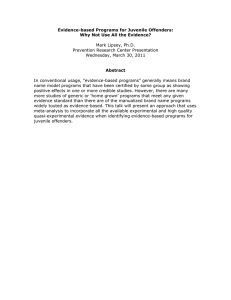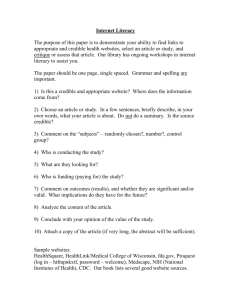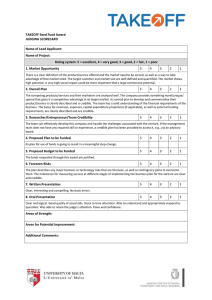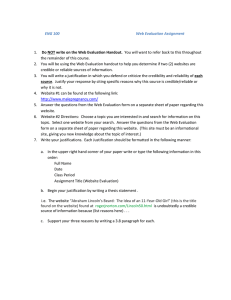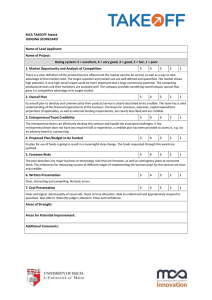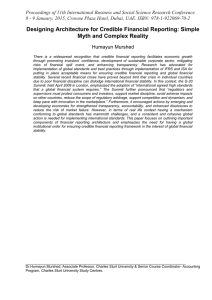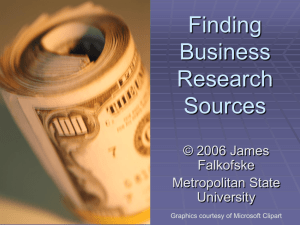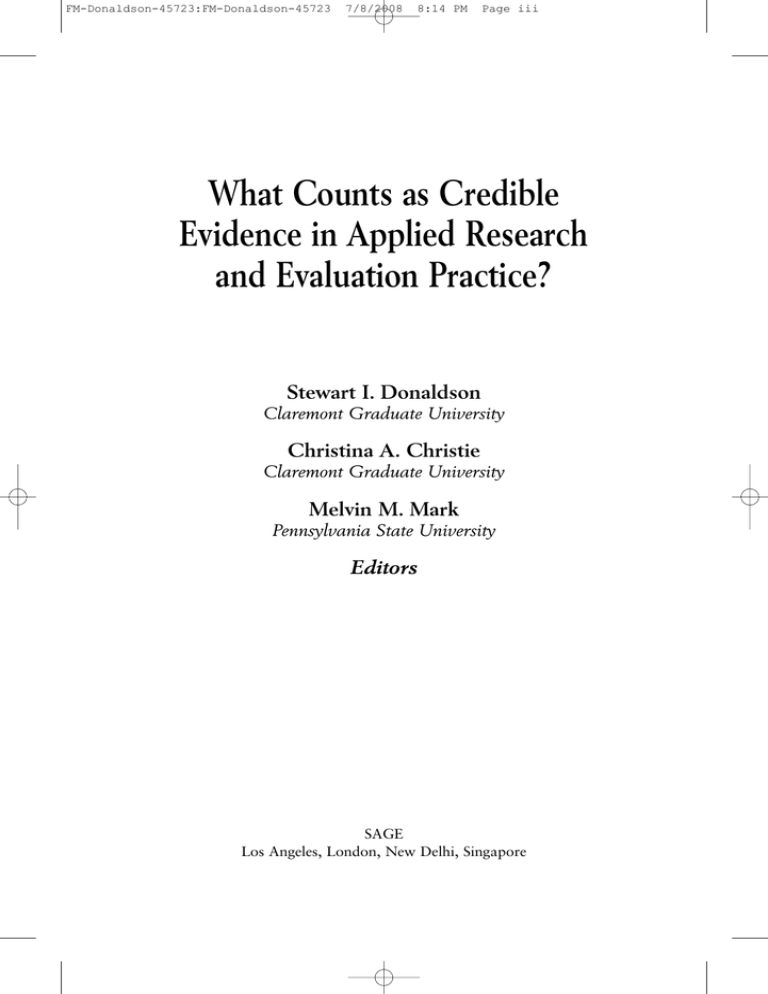
FM-Donaldson-45723:FM-Donaldson-45723
7/8/2008
8:14 PM
Page iii
What Counts as Credible
Evidence in Applied Research
and Evaluation Practice?
Stewart I. Donaldson
Claremont Graduate University
Christina A. Christie
Claremont Graduate University
Melvin M. Mark
Pennsylvania State University
Editors
SAGE
Los Angeles, London, New Delhi, Singapore
FM-Donaldson-45723:FM-Donaldson-45723
7/8/2008
8:14 PM
Page iv
Copyright © 2009 by Sage Publications, Inc.
All rights reserved. No part of this book may be reproduced or utilized in any form
or by any means, electronic or mechanical, including photocopying, recording, or by
any information storage and retrieval system, without permission in writing from
the publisher.
For information:
SAGE Publications, Inc.
2455 Teller Road
Thousand Oaks,
California 91320
E-mail: order@sagepub.com
SAGE Publications India Pvt. Ltd.
B 1/I 1 Mohan Cooperative
Industrial Area
Mathura Road, New Delhi 110 044
India
SAGE Publications Ltd.
1 Oliver’s Yard
55 City Road
London EC1Y 1SP
United Kingdom
SAGE Publications
Asia-Pacific Pte. Ltd.
33 Pekin Street #02-01
Far East Square
Singapore 048763
Printed in the United States of America
Library of Congress Cataloging-in-Publication Data
What counts as credible evidence in applied research and evaluation practice? /
Stewart I. Donaldson, Christina A. Christie, [and] Melvin M. Mark, editors.
p. cm.
Includes bibliographical references and index.
ISBN 978-1-4129-5707-6 (pbk.: acid-free paper)
1. Research—Evaluation. 2. Research—Social aspects. 3. Social sciences—
Methodology. 4. Evaluation research (Social action programs) 5. Educational
accountability. I. Donaldson, Stewart I. (Stewart Ian) II. Christie, Christina A.
III. Mark, Melvin M.
Q180.55.E9W53 2009
001.4′2—dc22
2008017667
This book is printed on acid-free paper.
08
09
10
11
12
Acquisitions Editor:
Editorial Assistant:
Production Editor:
Copy Editor:
Typesetter:
Proofreader:
Indexer:
Cover Designer:
Marketing Manager:
10
9
8
7
6
5
Vicki Knight
Lauren Habib
Catherine M. Chilton
Teresa Herlinger
C&M Digitals (P) Ltd.
Candice Harman
Stephanie Adams
4
3
2
1
01-Donaldson-45723:01-Donaldson-45723.qxp
7/8/2008
7:36 PM
Page 2
1
In Search of the Blueprint for an
Evidence-Based Global Society
Stewart I. Donaldson
A
s we near the end of the first decade of the 21st century, approximately
1.5 billion members of our vast global community live in pain and misery, and another 2.5 billion are also shut out of the “good life”—just simply
getting by, day by day (a total of 4 billion people; Gallup, 2007). On a
brighter note, there are now approximately 2 billion people on planet earth,
or 33% of the world’s population, who have a favorable standard of living
and report high levels of health and well-being on a regular basis (Gallup,
2007). This picture is obviously not good enough for those of us who devote
our lives and careers to conducting applied research and evaluation, in efforts
to prevent and ameliorate human misery and suffering, and to promote
social justice and human betterment.
Basic research is typically driven by scientists’ personal interests and
curiosity, and its purpose is to advance knowledge. In contrast, the purpose
of applied research is to understand how to prevent or solve practical problems that affect “real” people, organizations, communities, and societies
across the globe. Some applied research is descriptive and helps advance our
understanding of practical problems and their potential solutions, while
other efforts are evaluative and improve or determine the effectiveness
of actions (e.g., programs and policies) to prevent and solve practical
problems. Donaldson and Christie (2006) described some of the major
2
01-Donaldson-45723:01-Donaldson-45723.qxp
7/8/2008
7:36 PM
Page 3
The Blueprint for an Evidence-Based Global Society——3
differences between basic research and applied research and evaluation,
such as the origin of the study questions, the purposes for which study
information is gathered, and the settings in which the work is conducted.
For the purposes of this volume, we are going to focus on what counts as
credible evidence in applied research and evaluation. That is, most of the
scientific work we will be discussing is problem based or solution oriented,
and conducted in “real world” settings as opposed to highly controlled,
traditional scientific laboratories.
The Rise and Fall of the Experimenting Society
In 1969, one of the legendary figures in the history of applied research and
evaluation, Donald T. Campbell, gave us great hope and set what we now
call the “applied research and evaluation community” on a course for
discovering a utopia he called the “Experimenting Society” (Campbell,
1991). His vision for this utopia involved rational decision making by
politicians based on hard-headed tests of bold social programs designed to
improve society. The hard-headed tests he envisioned were called randomized experiments and were focused on maximizing bias control in an effort
to provide unambiguous causal inferences about the effects of social reforms.
This ideal society would broadly implement social reforms demonstrated
to be highly effective by experimental research and evaluation, with the
goal of moving at least more, if not most, of the population toward the
“good life.”
Some of the most important methodological breakthroughs in the history
of applied research and evaluation seemed to occur during this movement
toward the Experimenting Society (e.g., Campbell, 1991; Campbell &
Stanley, 1963; Cook & Campbell, 1979). For example, detailed understanding of threats to validity, multiple types of validity, bias control, and the
implementation of rigorous experimental and quasi-experimental designs in
“real world” or field settings were advanced during this era.
However, the progress and momentum of the movement were not sustained. By the early 1980s, it was clear that Campbell’s vision would be
crushed by the realities of programs, initiatives, and societal reforms. Shadish,
Cook, and Leviton (1991) reported that information or evidence judged to be
poor by experimental scientific standards, was often considered acceptable
by key decision makers including managers, politicians, and policy makers.
Further, they argued that rigorous experimental evaluations did not yield
credible evidence in a timely and useful manner, thus inspiring the field
to develop new tools, methods, and evaluation approaches. The practice of
01-Donaldson-45723:01-Donaldson-45723.qxp
7/8/2008
7:36 PM
Page 4
4——Introduction
applied research and evaluation today has moved way beyond the sole
reliance on experimentation and traditional social science research methods
(Donaldson, 2007; Donaldson & Lipsey, 2006; Donaldson & Scriven, 2003).
An Evidence-Based Global Society
Shades of Campbell’s great hopes for evidence-based decision making can be
seen in much of the applied research and evaluation discourse today.
However, while the modern discussion remains focused on the importance
of the production and use of credible evidence, it is not limited to evidence
derived from experimentation. The new vision for a utopia seems to require
broadening Campbell’s vision from an “experimenting” to an “evidencebased society.” This ideal society would certainly include evidence from
experimentation under its purview, but would also include a wide range of
evidence derived from other applied research and evaluation designs and
approaches. Many of these newer approaches have been developed in the past
two decades and no longer rely primarily on the traditional social science
experimental paradigm (see Alkin, 2004; Donaldson & Scriven, 2003).
The momentum for developing an evidence-based global society seems to
be at an all-time peak. No longer is applied research and evaluation primarily concentrated in Washington, D.C., or federal governments more broadly.
Rather, organizations of all types, shapes, and sizes are commissioning
applied research and professional evaluations in pursuit of evidence-based
decision making at an accelerating rate.
One striking indicator of the demand for evidence and the growth of
applied research and evaluation is the popularity of professional societies
across the globe. For example, in 1980 there were only three national and
regional evaluation societies. This number almost doubled (five) by 1990. Just
one decade later (by 2000), there were more than 50 professional evaluation
societies, and today there are more than 75 with a formal international cooperation network to build evaluation capacity across the globe (Donaldson,
2007; Donaldson & Christie, 2006). Members of most of these societies meet
regularly to learn and discuss how best to conduct applied research and evaluation in order to yield credible evidence for promoting human betterment.
Another window into the promise of an evidence-based society and the
accelerating demand for credible evidence, is the recent proliferation of
evidence-based discussions and applications. For example, these discussions
and applications are now prevalent throughout the fields of health care and
medicine (Sackett, 2000; Sackett, Rosenberg, Gray, & Haynes, 1996),
mental health (Norcross, Beutler, & Levant, 2005), management (Pfeffer &
01-Donaldson-45723:01-Donaldson-45723.qxp
7/8/2008
7:36 PM
Page 5
The Blueprint for an Evidence-Based Global Society——5
Sutton, 2006), executive coaching (Stober & Grant, 2006), career development (Preskill & Donaldson, 2008), public policy (Pawson, 2006), and education (Chapter 5, this volume) just to name a few. In fact, a cursory search
on Google yields many more applications of evidence-based practice. A sample of the results of a recent search illustrates these diverse applications:
•
•
•
•
•
•
•
•
•
•
•
•
•
•
•
•
•
•
•
•
Evidence-based medicine
Evidence-based mental health
Evidence-based management
Evidence-based decision making
Evidence-based education
Evidence-based coaching
Evidence-based social services
Evidence-based policing
Evidence-based conservation
Evidence-based dentistry
Evidence-based policy
Evidence-based thinking about health care
Evidence-based occupational therapy
Evidence-based prevention science
Evidence-based dermatology
Evidence-based gambling treatment
Evidence-based sex education
Evidence-based needle exchange programs
Evidence-based prices
Evidence-based education help desk
One might even consider this interesting new phenomenon across the
disciplines to be expressed in the following formula:
Mom + The Flag + Apple Pie = Evidence-Based Practice
Or it might be expressed as
In God We Trust—All Others Must Have Credible Evidence
The main point here is the movement toward evidence-based decision
making now appears highly valued across the globe, multidisciplinary in
scope, and supported by an ever-increasing number of practical applications.
But wait—while there appears to be strong consensus that evidence is our
“magic bullet” and a highly valued commodity in the fight against social
problems, there ironically appears to be much less agreement, even heated
01-Donaldson-45723:01-Donaldson-45723.qxp
7/8/2008
7:36 PM
Page 6
6——Introduction
disagreements, about what counts as evidence. Unfortunately, seeking truth
or agreement about what constitutes credible evidence does not seem to be
an easy matter in many fields. Even in periods of relative calm and consensus in the development of a discipline, innovations occur and worldviews
change in ways that destabilize. We may be living in such a destabilizing
period now in the profession and discipline of applied research and evaluation. That is, despite unprecedented growth and success on many fronts, the
field is in considerable turmoil over its very foundation—what counts as
credible evidence. Furthermore, contemporary applied research and evaluation practice rests firmly on the foundation of providing credible evidence. If
that foundation is shaky, or built on sand, studies wobble, sway in the wind,
and ultimately provide little value, and can even mislead or harm.
Recent Debates About Evidence
Before exploring this potentially destructive strife and dilemma in more detail,
let’s briefly look at the recent history of debates about applied research and
evaluation. The great quantitative-qualitative debate captured and occupied
the field throughout the late 1970s and 1980s (see Reichhardt & Rallis, 1994).
This rather lengthy battle also become known as the “Paradigm Wars,” which
seemed to quiet down a bit by the turn of the century (Mark, 2003).
In 2001, Donaldson and Scriven (2003) invited a diverse group of applied
researchers and evaluators to provide their visions for a desired future. The
heat generated at this symposium suggested that whatever truce or peace had
been achieved remained an uneasy one (Mark, 2003). For example, Yvonna
Lincoln and Donna Mertons envisioned a desirable future based on constructivist philosophy, and Mertons seemed to suggest that the traditional
quantitative social science paradigm, specifically randomized experiments,
were an immoral methodology (Mark, 2003). Thomas Cook responded with
a description of applied research and evaluation in his world, which primarily involved randomized and quasi-experimental designs, as normative and
highly valued by scientists, funders, stakeholders, and policy makers alike.
Two illustrative observations by Mark (2003) highlighting differences
expressed in the discussion were (1) “I have heard some quantitatively oriented evaluators disparage participatory and empowerment approaches
as technically wanting and as less than evaluation,” and (2) “It can, however, seem more ironic when evaluators who espouse inclusion, empowerment, and participation would like to exclude, disempower, and see no
participation by evaluators who hold different views.” While the symposium
concluded with some productive discussions about embracing diversity and
01-Donaldson-45723:01-Donaldson-45723.qxp
7/8/2008
7:36 PM
Page 7
The Blueprint for an Evidence-Based Global Society——7
integration as ways to move forward, it was clear there were lingering
differences and concerns about what constitutes quality applied research,
evaluation, and credible evidence.
Donaldson and Christie (2005) noted that the uneasy peace seemed to
revert back to overt conflict in late 2003. The trigger event occurred when the
U.S. Department of Education’s Institute of Education Sciences declared a
rather wholesale commitment to privileging experimental and some types of
quasi-experimental designs over other methods in applied research and evaluation funding competitions. At the 2003 Annual Meeting of the American
Evaluation Association (AEA), prominent applied researchers and evaluators
discussed this event as a move back to the “Dark Ages” (Donaldson &
Christie, 2005). The leadership of the American Evaluation Association
developed a policy statement opposing these efforts to privilege randomized
control trials in education evaluation funding competitions:
AEA Statement:
American Evaluation Association Response
to U. S. Department of Education
Notice of Proposed Priority, Federal Register
RIN 1890-ZA00, November 4, 2003
“Scientifically Based Evaluation Methods”
The American Evaluation Association applauds the effort to promote high
quality in the U.S. Secretary of Education’s proposed priority for evaluating
educational programs using scientifically based methods. We, too, have worked
to encourage competent practice through our Guiding Principles for Evaluators
(1994), Standards for Program Evaluation (1994), professional training, and
annual conferences. However, we believe the proposed priority manifests fundamental misunderstandings about (1) the types of studies capable of determining causality, (2) the methods capable of achieving scientific rigor, and
(3) the types of studies that support policy and program decisions. We would
like to help avoid the political, ethical, and financial disaster that could well
attend implementation of the proposed priority.
(1) Studies capable of determining causality. Randomized control group
trials (RCTs) are not the only studies capable of generating understandings of causality. In medicine, causality has been conclusively shown in
(Continued)
01-Donaldson-45723:01-Donaldson-45723.qxp
7/8/2008
7:36 PM
Page 8
8——Introduction
(Continued)
some instances without RCTs, for example, in linking smoking to lung
cancer and infested [sic] rats to bubonic plague. The secretary’s proposal would elevate experimental over quasi-experimental, observational, single-subject, and other designs which are sometimes more
feasible and equally valid.
RCTs are not always best for determining causality and can be misleading.
RCTs examine a limited number of isolated factors that are neither limited nor
isolated in natural settings. The complex nature of causality and the multitude
of actual influences on outcomes render RCTs less capable of discovering
causality than designs sensitive to local culture and conditions and open to
unanticipated causal factors.
RCTs should sometimes be ruled out for reasons of ethics. For example,
assigning experimental subjects to educationally inferior or medically unproven
treatments, or denying control group subjects access to important instructional
opportunities or critical medical intervention, is not ethically acceptable even
when RCT results might be enlightening. Such studies would not be approved
by Institutional Review Boards overseeing the protection of human subjects in
accordance with federal statute.
In some cases, data sources are insufficient for RCTs. Pilot, experimental,
and exploratory education, health, and social programs are often small enough
in scale to preclude use of RCTs as an evaluation methodology, however important it may be to examine causality prior to wider implementation.
(2) Methods capable of demonstrating scientific rigor. For at least a decade,
evaluators publicly debated whether newer inquiry methods were sufficiently rigorous. This issue was settled long ago. Actual practice and
many published examples demonstrate that alternative and mixed
methods are rigorous and scientific. To discourage a repertoire of methods would force evaluators backward. We strongly disagree that the
methodological “benefits of the proposed priority justify the costs.”
(3) Studies capable of supporting appropriate policy and program decisions. We also strongly disagree that “this regulatory action does not
unduly interfere with State, local, and tribal governments in the exercise of their governmental functions.” As provision and support of programs are governmental functions so, too, is determining program
effectiveness. Sound policy decisions benefit from data illustrating not
only causality but also conditionality. Fettering evaluators with unnecessary and unreasonable constraints would deny information needed
by policy-makers.
01-Donaldson-45723:01-Donaldson-45723.qxp
7/8/2008
7:36 PM
Page 9
The Blueprint for an Evidence-Based Global Society——9
While we agree with the intent of ensuring that federally sponsored programs be “evaluated using scientifically based research . . . to determine the
effectiveness of a project intervention,” we do not agree that “evaluation methods using an experimental design are best for determining project effectiveness.” We believe that the constraints in the proposed priority would deny use
of other needed, proven, and scientifically credible evaluation methods, resulting in fruitless expenditures on some large contracts while leaving other public
programs unevaluated entirely.
Donaldson and Christie (2005) documented an important response to the
AEA Statement from an influential group of senior members. This group
opposed the AEA Statement, and did not feel they were appropriately consulted as active, long-term members of the association. There response
became known as “The Not AEA Statement.”
The Not AEA Statement:
(Posted on EvalTalk, December 3, 2003; available at http://bama.ua.edu/
archives/evaltalk.html)
AEA members:
The statement below has been sent to the Department of Education in
response to its proposal that “scientifically based evaluation methods” for
assessing the effectiveness of educational interventions be defined as randomized experiments when they are feasible and as quasi-experimental or singlesubject designs when they are not.
This statement is intended to support the Department’s definition and associated preference for the use of such designs for outcome evaluation when they
are applicable. It is also intended to provide a counterpoint to the statement submitted by the AEA leadership as the Association’s position on this matter. The
generalized opposition to use of experimental and quasi-experimental methods
evinced in the AEA statement is unjustified, speciously argued, and represents
neither the methodological norms in the evaluation field nor the views of the
large segment of the AEA membership with significant experience conducting
experimental and quasi-experimental evaluations of program effects.
We encourage all AEA members to communicate their views on this matter
to the Department of Education and invite you to endorse the statement below
(Continued)
01-Donaldson-45723:01-Donaldson-45723.qxp
7/8/2008
7:36 PM
Page 10
10——Introduction
(Continued)
in that communication if it is more representative of your views than the official
AEA statement. Comments can be sent to the Dept of Ed through Dec. 4 at
comments@ed.gov with “Evaluation” in the subject line of the message.
This statement is in response to the Secretary’s request for comment on the
proposed priority on Scientifically Based Evaluation Methods. We offer the
following observations in support of this priority.
The proposed priority identifies random assignment experimental designs
as the methodological standard for what constitutes scientifically based evaluation methods for determining whether an intervention produces meaningful
effects on students, teachers, parents, and others. The priority also recognizes
that there are cases when random assignment is not feasible and, in such
cases, identifies quasi-experimental designs and single-subject designs as alternatives that may be justified by the circumstances of particular evaluations.
This interpretation of what constitutes scientifically based evaluation strategies for assessing program effects is consistent with the presentations in the
major textbooks in evaluation and with widely recognized methodological standards in the social and medical sciences. Randomized controlled trials have been
essential to understanding what works, what does not work, and what is harmful
among interventions in many other areas of public policy including health and
medicine, mental health, criminal justice, employment, and welfare. Furthermore,
attempts to draw conclusions about intervention effects based on nonrandomized trials have often led to misleading results in these fields and there is no
reason to expect this to be untrue in the social and education fields. This is
demonstrated, for example, by the results of randomized trials of facilitated communication for autistic children and prison visits for juvenile offenders, which
reversed the conclusions of nonexperimental studies of these interventions.
Randomized trials in the social sector are more frequent and feasible than many
critics acknowledge and their number is increasing. The Campbell Collaboration of
Social, Psychological, Educational, and Criminological Trials Register includes nearly
13,000 such trials, and the development of this register is still in its youth.
At the same time, we recognize that randomized trials are not feasible or
ethical at times. In such circumstances, quasi-experimental or other designs
may be appropriate alternatives, as the proposed priority allows. However, it
has been possible to configure practical and ethical experimental designs in
such complex and sensitive areas of study as pregnancy prevention programs,
police handling of domestic violence, and prevention of substance abuse. It is
similarly possible to design randomized trials or strong quasi-experiments to be
ethical and feasible for many educational programs. In such cases, we believe
the Secretary’s proposed priority gives proper guidance for attaining high
methodological standards and we believe the nation’s children deserve to have
educational programs of demonstrated effectiveness as determined by the
most scientifically credible methods available.
01-Donaldson-45723:01-Donaldson-45723.qxp
7/8/2008
7:36 PM
Page 11
The Blueprint for an Evidence-Based Global Society——11
The individuals who have signed below in support of this statement are
current or former members of the American Evaluation Association (AEA).
Included among us are individuals who have been closely associated with that
organization since its inception and who have served as AEA presidents, Board
members, and journal editors. We wish to make clear that the statement submitted by AEA in response to this proposed priority does not represent our
views and we regret that a statement representing the organization was proffered without prior review and comment by its members. We believe that the
proposed priority will dramatically increase the amount of valid information for
guiding the improvement of education throughout the nation. We appreciate
the opportunity to comment on a matter of this importance and support the
Department’s initiative.
The subsequent exchanges about these statements on the AEA’s electronic
bulletin board, EvalTalk, seemed to generate much more heat than light and
begged for more elaboration on the issues. As a result, Claremont Graduate
University hosted and webcasted a debate for the applied research and evaluation community in 2004. The debate was between Mark Lipsey and
Michael Scriven, and it attempted to sort out the issues at stake and to search
for a common ground.
Donaldson and Christie (2005) concluded
somewhat surprisingly, that Lipsey and Scriven agreed that randomized control trials (RCTs) are the best method currently available for assessing program
impact (causal effects of a program), and that determining program impact is
a main requirement of contemporary program evaluation. However, Scriven
argued that there are very few situations where RCTs can be successfully
implemented in educational program evaluation, and that there are now good
alternative designs for determining program effects. Lipsey disagreed and
remained very skeptical of Scriven’s claim that sound alternative methods exist
for determining program effects, and challenged Scriven to provide specific
examples. (p. 77)
What Counts as Credible Evidence?
In 2006, the debate about whether randomized controlled trials (RCTs)
should be considered the gold standard for producing credible evidence in
applied research and evaluation remained front and center across the applied
research landscape. At the same time, the zeitgeist of accountability and
evidence-based practice was now widespread across the globe. Organizations
of all types and sizes were being asked to evaluate their practices, programs,
01-Donaldson-45723:01-Donaldson-45723.qxp
7/8/2008
7:36 PM
Page 12
12——Introduction
and policies at an increasing rate. While there seemed to be much support
for the notion of using evidence to continually improve efficiency and effectiveness, there appeared to be growing disagreement and confusion about
what constitutes sound evidence for decision making. These heated disagreements among leading lights in the field had potentially far-reaching
implications for evaluation and applied research practice, for the future of
the profession (e.g., there was visible disengagement, public criticisms, and
resignations from the main professional associations), for funding competitions, as well as for how best to conduct and use evaluation and applied
research to promote human betterment.
So in light of this state of affairs, an illustrious group of experts working
in various areas of evaluation and applied research were invited to
Claremont Graduate University to share their diverse perspectives on the
question of “What Counts as Credible Evidence?” The ultimate goal of this
symposium was to shed more light on these issues, and to attempt to build
bridges so that prominent leaders on both sides of the debate would stay
together in a united front against the social and human ills of the 21st century. In other words, a full vetting of best ways to produce credible evidence
from both an experimental and nonexperimental perspective was facilitated
in the hope that the results would move us closer to a shared blueprint for
an evidence-based global society.
This illuminating and action-packed day in Claremont, California,
included over 200 attendees from a variety of backgrounds—academics,
researchers, private consultants, students, and professionals from many
fields—who enjoyed a day of stimulating presentations, intense discussion,
and a display of diverse perspectives on this central issue facing the field (see
webcast at www.cgu.sbos). Each presenter was asked to follow up his or her
presentation with a more detailed chapter for this book. In addition, George
Julnes and Debra Rog were invited to contribute a chapter based on their
findings from a recent project focused on informing federal policies on evaluation methodology (Julnes & Rog, 2007).
Our search for a deeper and more complete understanding of what counts
as credible evidence begins with an analysis of the passion, paradigms, and
assumptions that underlie many of the arguments and perspectives expressed
throughout this book. In Chapter 2, Christina Christie and Dreolin Fleischer
provide us with a rich context for understanding the nature and importance
of this debate. Ontological, epistemological, and methodological assumptions that anchor views about the nature of credible evidence are explored.
This context is used to preview the positions expressed about credible
evidence in the subsequent sections of the book.
01-Donaldson-45723:01-Donaldson-45723.qxp
7/8/2008
7:36 PM
Page 13
The Blueprint for an Evidence-Based Global Society——13
Experimental Routes to Credible Evidence
Part II contains four chapters that discuss the importance of experimental
and quasi-experimental approaches for producing credible and actionable
evidence in applied research and evaluation. In Chapter 3, Gary Henry
sketches out an underlying justification for the U.S. Department of
Education’s priority for randomized experiments and high quality quasiexperiments over nonexperimental designs “when getting it right matters.”
His argument has deep roots in democratic theory, and stresses the importance of scientifically based evaluations for influencing the adoption of government policies and programs. He argues that high-quality, experimental
evaluations are the only way to eliminate selection bias when assessing
policy and program impact, and that malfeasance may occur when random
assignment evaluations are not conducted. Henry urges his readers to consider his arguments in favor of the proposed priority in an open-minded,
reflective, and deliberative way to do the greatest good in society.
In Chapter 4, Leonard Bickman and Stephanie Reich explore in great detail
why RCTs are commonly considered the “gold standard” for producing credible evidence in applied research and evaluation. They clearly articulate why
RCTs are superior to other evaluation designs for determining causation and
impact, and alert us to the high cost of making a wrong decision about causality. They specify numerous threats to validity that must be considered in
applied research and evaluation, and provide a thorough analysis of both the
strengths and limitations of RCTs. In the end, they conclude that, “For determining causality, in many but not all circumstances, the randomized design is
the worst form of design except all the others that have been tried.”
One popular approach for determining if evidence from applied research
and evaluation is credible for decision making has been to establish what
might be thought of as “supreme courts” of credible evidence. These groups
establish evidence standards and identify studies that provide the strongest
evidence for decision and policy making. For example, the Cochrane
Collaboration is known as the reliable source for evidence on the effects of
health care interventions, and it aims to improve health care decision making
globally (www.cochrane.org). The Campbell Collaboration strives to provide
decision makers with evidence-based information to empower them to make
well-informed decisions about the effects of interventions in the social, behavioral, and educational arenas (www.campbellcollaboration.org). In Chapter 5,
Russell Gersten and John Hitchcock describe the role of the What Works
Clearinghouse (WWC) in informing decision makers and being the “trusted
source of scientific evidence in education” (http://ies.ed.gov/ncee/wwc). They
01-Donaldson-45723:01-Donaldson-45723.qxp
7/8/2008
7:36 PM
Page 14
14——Introduction
discuss in some detail how the Clearinghouse defines and determines credible
evidence for the effectiveness of a wide range of educational programs and
interventions. It is important to note that well-implemented RCTs are typically required to meet the highest standards in most of these evidence collaborations and clearinghouses, and applied research and evaluations that do not
use RCTs or strong quasi-experimental designs do not make it through the
evidence screens or meet credible evidence standards.
George Julnes and Debra Rog discuss their new work on informing
method choice in applied research and evaluation in Chapter 6. Their pragmatic approach suggests that for evidence to be useful, it not only needs to
be credible but “actionable” as well, deemed both adequate and appropriate
for guiding actions in targeted real-world contexts. They argue that evidence
can be credible in the context studied but of questionable relevance for guiding actions in other contexts. They provide a framework to address the controversy over method choice and review areas where there is at least some
consensus, in particular with regard to the key factors that make one method
more or less suitable than others for particular situations. The contexts and
contingencies under which RCTs and quasi-experimental designs are most
likely to thrive in providing credible and actionable evidence are described.
They conclude by suggesting that their approach to the debate about evidence, focusing on the specific application of methods and designs in applied
research and evaluation, promises to develop a “fairer” playing field in the
debate about credible evidence than one that is based solely on ideological
instead of pragmatic grounds.
Nonexperimental Approaches
Part III includes five chapters that explore nonexperimental approaches
for building credible evidence in applied research and evaluation. Michael
Scriven (Chapter 7) first takes a strong stand against the “current mythology
that scientific claims of causation or good evidence require evidence from
RCTs.” He asserts, “to insist that we use an experimental approach is simply bigotry, not pragmatic, and not logical—in short a dogmatic approach
that is an affront to scientific method. And to wave banners proclaiming that
anything less will mean unreliable results or unscientific practice is simply
absurd.” Next, he provides a detailed analysis of alternative ways to determine causation in applied research and evaluation, and discusses several
alternative methods for determining policy and program impact including
the general elimination methodology or algorithm (GEM). He ends with a
proposal for marriage of warring parties, complete with a prenuptial agreement,
01-Donaldson-45723:01-Donaldson-45723.qxp
7/8/2008
7:36 PM
Page 15
The Blueprint for an Evidence-Based Global Society——15
that he believes would provide a win-win solution to the “causal wars,” with
major positive side effects for those in need around the world.
In Chapter 8, Jennifer Greene outlines the political, organizational, and
sociocultural assumptions and stances that comprise the current context for
the demand for credible evidence. She quotes Stronach, Piper, and Piper
(2004), “The positivists can’t believe their luck, they’ve lost all the arguments
of the last 30 years and they’ve still won the war,” to illuminate that the
worldview underlying the current demand for credible evidence is a form of
conservative post-positivism, or in many ways like a kind of neo-positivism.
She laments that “many of us thought we’d seen the last of this obsolete way
of thinking about the causes and meaning of human activity, as it was a consensual casualty of the great quantitative-qualitative debate.” She goes on to
describe the ambitions and politics behind priorities and approaches privileging methods and designs like RCTs, and the problems with efforts to promote
one master epistemology and the interests of the elite, which she concludes is
radically undemocratic. Greene offers us an alternative view on credible evidence that meaningfully honors complexity, and modestly views evidence as
“inkling” in contrast to “proof.” She describes how credible evidence can
provide us a window into the messy complexity of human experience; needs
to account for history, culture, and context; respects differences in perspective
and values; and opens the potential for democratic inclusion and the legitimization of multiple voices.
Sharon Rallis describes qualitative pathways for building credible evidence in Chapter 9. She emphasizes throughout her chapter that probity,
goodness or absolute moral correctness, is as important as rigor in determining what counts as credible evidence in applied research and evaluation.
It is also important to her that scientific knowledge be recognized as a social
construct, and that credible evidence is what the relevant communities of
discourse and practice accept as valid, reliable, and trustworthy. A wide
range of examples focused on reported experiences rather than outcomes are
provided, and offered as a form of credible evidence to help improve policy
and programming and to better serve the people involved. Rallis argues that
these qualitative experiences provide credible evidence that is the real basis
of scientific inquiry.
In Chapter 10, Sandra Mathison explores the credibility of image-based
applied research and evaluation. She asserts that the credibility of evidence
is contingent on experience, perception, and social convention. Mathison
introduces the notion of an anarchist epistemology, the notion that every
idea, however new or absurd, may improve knowledge of the social world.
She asserts that credible evidence is not the province of only certain methods
(e.g., RCTs), and can’t be expressed in only one way (e.g., statistical averages).
01-Donaldson-45723:01-Donaldson-45723.qxp
7/8/2008
7:36 PM
Page 16
16——Introduction
Qualities of good evidence include relevance, coherence, verisimilitude,
justifiability, and contextuality. She concludes by pointing out that it is too
simplistic to assert that “seeing is believing,” but the fact that our eyes sometimes deceive does not obviate credible knowing from doing and viewing
image-based research and evaluation.
Thomas Schwandt provides the final chapter of Part III. He claims that
evaluating the merit, worth, and significance of our judgments, actions, policies, and programs requires a variety of evidence generated via both experimental and nonexperimental methods. He asserts in Chapter 11 that RCTs
are not always the best choice of study design, and in some situations do not
provide more credible evidence than nonrandomized study designs. That is,
observational studies often provide credible evidence as well. Schwandt
believes that careful thinking about the credibility, relevance, and probative
value of evidence in applied research and evaluation will not be advanced in
the future by continuing to argue and debate the merits of hierarchies of evidence as a basis for decision making. Rather, he suspects that the field of
applied research and evaluation would be better served by working more
diligently on developing a practical theory of evidence, one that addressed
matters such as the nature of evidence as well as the context and ethics of its
use in decision making.
Conclusions
In Chapter 12, the final chapter, Melvin Mark reviews some of the central
themes about credible evidence presented throughout the book, and underscores that at this time in our history this is a topic where we do not have
consensus. For example, some authors firmly believe that RCTs are needed
to have credible and actionable evidence about program effects, while others assume that nonexperimental methods will suffice for that purpose, and
yet other authors argue that the question of overall program effects is too
complex to answer in a world in which context greatly matters. In an effort
to move the field forward in a productive and inclusive manner, Mark provides us with an integrative review of the critical issues raised in the debate,
and identifies a few underlying factors that account for much of the diversity in the views about what counts as credible evidence. He concludes by
giving us a roadmap for changing the terms of a debate that he believes will
help us dramatically improve our understanding of what counts as credible
evidence in applied research and evaluation.
The Epilogue by Donaldson supports and expands this roadmap and
begins to flesh out a possible blueprint for an evidence-based global society.
01-Donaldson-45723:01-Donaldson-45723.qxp
7/8/2008
7:36 PM
Page 17
The Blueprint for an Evidence-Based Global Society——17
Together, Mark and Donaldson provide us with hope that the result of this
volume will be to inspire new efforts to improve our understanding of deeply
entrenched disagreements about evidence, move us toward a common
ground where such can be found, enhance the capacity of evaluation practitioners and stakeholders to make sensible decisions rather than draw allegiances to a side of the debate based on superficial considerations, and
ultimately provide applied researchers and evaluators with a useful framework for gathering and using credible evidence to improve the plight of
humankind across the globe as we move further into the 21st century.
References
Alkin, M. C. (2004). Evaluation roots: Tracing theorists’ views and influences.
Thousand Oaks, CA: Sage Publications.
Campbell, D. T. (1991). Methods for the experimenting society. American Journal of
Evaluation, 12(3), 223–260.
Campbell, D. T., & Stanley, J. C. (1963). Experimental and quasi-experimental design
for research. Chicago: Rand McNally.
Campbell Collaboration website: www.campbellcollaboration.org.
Cochrane Collaboration website: www.cochrane.org.
Cook, T. D., & Campbell, D. T. (1979). Quasi-experimentation: Design and analysis
issues for field settings. Chicago: Rand McNally.
Donaldson, S. I. (2007). Program theory–driven evaluation science: Strategies and
applications. Mahwah, NJ: Erlbaum.
Donaldson, S. I., & Christie, C. A. (2005). The 2004 Claremont Debate: Lipsey versus Scriven. Determining causality in program evaluation and applied research:
Should experimental evidence be the gold standard? Journal of Multidisciplinary
Evaluation, 3, 60–77.
Donaldson, S. I., & Christie, C. A. (2006). Emerging career opportunities in the transdiscipline of evaluation science. In S. I. Donaldson, D. E. Berger, & K. Pezdek
(Eds.), Applied psychology: New frontiers and rewarding careers. Mahwah,
NJ: Erlbaum.
Donaldson, S. I., & Lipsey, M. W. (2006). Roles for theory in contemporary evaluation practice: Developing practical knowledge. In I. Shaw, J. C. Greene, &
M. M. Mark (Eds.), The handbook of evaluation: Policies, programs, and practices (pp. 56–75). London: Sage Publications.
Donaldson, S. I., & Scriven, M. (2003). Evaluating social programs and problems:
Visions for the new millennium. Mahwah, NJ: Erlbaum.
Gallup. (2007). The state of global well-being 2007. New York: Gallup Press.
Joint Committee on Standards for Education Evaluation (1994). The program evaluation standards: How to assess evaluations of educational programs. Newbury
Park, CA: Sage Publications.
01-Donaldson-45723:01-Donaldson-45723.qxp
7/8/2008
7:36 PM
Page 18
18——Introduction
Julnes, G., & Rog, D. J. (Eds.). (2007). Informing federal policies on evaluation
methodology: Building the evidence base for method choice in governmentsponsored evaluations [Entire issue]. (Vol. 113 of New Directions for Evaluation
series). San Francisco: Jossey-Bass.
Mark, M. M. (2003). Toward an integrative view of the theory and practice of
program and policy evaluation. In S. I. Donaldson & M. Scriven (2003.),
Evaluating social programs and problems: Visions for the new millennium
(pp. 109–141). Mahwah, NJ: Erlbaum.
Norcross, J. C., Beutler, L. E., & Levant, R. F. (2005). Evidence-based practices in
mental health: Debate and dialogue on the fundamental questions. Washington,
DC: American Psychological Association.
Pawson, R. (2006). Evidence-based policy: A realist perspective. London: Sage Publications.
Pfeffer, J., & Sutton, R. I. (2006). Hard facts, dangerous truths, and total nonsense:
Profiting from evidence-based management. Boston: Harvard Business School
Press.
Preskill, H., & Donaldson, S. I. (2008). Improving the evidence base for career development programs: Making use of the evaluation profession and positive psychology movement. Advances in Developing Human Resources, 10(1), 104–121.
Reichhardt, C., & Rallis, C. S. (1994). The qualitative–quantitative debate: New perspectives [Entire issue]. (Vol. 61 in New Directions for Program Evaluation
series). San Francisco: Jossey-Bass.
Sackett, D. L. (2000). Evidence-based medicine: How to practice and teach EBM.
Edinburgh/New York: Churchill Livingstone.
Sackett, D. L., Rosenberg, W. M. C., Gray, J. A. M., & Haynes, R. B. (1996). Evidencebased medicine: What it is and what it isn’t. British Medical Journal, 312, 71–72.
Shadish, W. R., Cook, T. D., & Leviton, L. C. (1991). Foundations of program evaluation: Theories of practice. Newbury Park, CA: Sage Publications.
Stober, D. R., & Grant, A. M. (2006). Evidence-based coaching handbook: Putting
best practice to work for your clients. Hoboken, NJ: Wiley.
Stronach, I., Piper, H., & Piper, J. (2004). Re-performing crises of representation.
In H. Piper & I. Stronach (Eds.), Educational research, difference and diversity
(pp. 129–154). Aldershot, UK: Ashgate.
What Works Clearinghouse website: http://ies.ed.gov/ncee/wwc.

